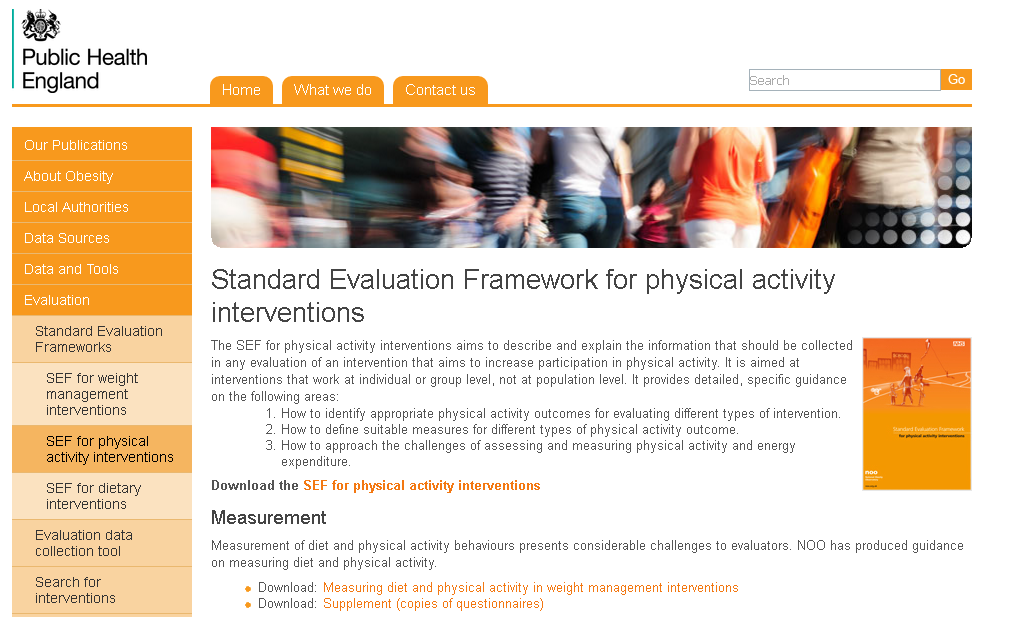
We hope that through the breadth of ‘Health Matters – getting every adult active every day’ content, we have made the case for investment of time and money, but a question may remain; what tools and resources are available to support professionals in making an impact?
Physical activity framework
If you haven’t already viewed Everybody Active Every Day take a look at this national physical activity framework which is based on international evidence of what works and was co-produced with over 1,000 local and national stakeholders. It is also supported by a document summarising what works – the evidence, which collates the underpinning evidence with options for actions across sectors and stakeholders.
Active society
Cultural change is required to shift the social norm to make activity the easy, default choice.
PHE’s One You campaign supports adults to understand and make changes in lifestyle behaviours. A range of personalised tools are available such as the One You Couch to 5k phone app, designed to help get people off the couch and running in just 9 weeks. Resources to help partners support One You are available from PHE’s campaign resource centre.
You can also use the This Girl Can toolkit to create local promotional materials to support the campaign and encourage greater physical activity among women.
Moving professionals
We need to develop expertise and leadership for physical activity amongst the professionals and volunteers who engage with the public on a daily basis.
NICE guidance on brief physical activity advice for adults recommends that those working in primary care should identify adults who are not currently meeting the UK physical activity guidelines. The guidance stresses that it is important not to rely on visual cues but to use validated tools such as the General Practice Physical Activity Questionnaire (GPPAQ) to assess physical activity levels.
PHE has developed a cadre of Clinical Champions to provide peer-to-peer training. This provides free structured training to health professionals by health professionals to improve the understanding of physical activity in clinical practice so they can integrate very brief advice into their day to day clinical practice. Through a partnership with Sport England this is being rolled out across the country linking to local training infrastructure.
PHE has published a suite of free, CPD e-learning modules on physical activity in the treatment of long-term conditions, and on motivational interviewing in brief consultations. It has also supported the development of infographics for health professionals to explain the UK Chief Medical Officers guidance to adults, children and young people and (soon) under-fives.
Active environments
Environment shapes behaviour and we need to create an environment that is conducive to rather than discourages physical activity.
PHE and Sport England have produced guidance on active design which looks at the opportunities to encourage and promote physical activity through the design and layout of the built environment.
NICE has also produced a suite of guidance to support increased levels of physical activity, including guidance on the promotion and creation of physical environments, physical activity in the workplace and walking and cycling.
And PHE has produced a briefing for transport planners or public health experts, making the case for work to incentivise walking and cycling instead of using the car for everyday journeys.
Moving at scale
To make an impact at population level, we need to identify and scale up ‘what works’.
Understanding the need and therefore potential for improvement is the first step. PHE’s Public Health and Outcomes Framework shows the percentage of physically active and inactive adults in your local area. It’s also worth triangulating with other population-level sources of physical activity data, such as the National Travel Survey or the Labour Force Survey, to better understand the nature of that activity.
PHE’s Standard Evaluation Framework for physical activity aims to describe and explain the information that should be collected in any evaluation of an intervention that aims to increase participation in physical activity. It is aimed at interventions that work at individual or group level, not at population level.
There are a range of tools to help make the economic case for taking action; PHE has provided a guide to online tools for valuing programmes. These include NICE’s return on investment tool to help commissioners make decisions about their choice of interventions.
Health Matters
Health Matters is a resource for professionals which brings together the latest data and evidence, makes the case for effective public health interventions and highlights tools and resources that can facilitate local or national action. Visit the Health Matters area of GOV.UK or sign up to receive the latest updates through our e-bulletin. If you found this blog helpful, please view other Health Matters blogs.


